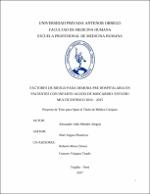Factores de riesgo para demora pre hospitalaria en pacientes con infarto agudo de miocardio. Estudio multicentrico 2010 - 2015

View/
Download
(application/pdf: 913.4Kb)
(application/pdf: 913.4Kb)
Date
2017Author(s)
Mendez Alegria, Alexander Aldo
Metadata
Show full item recordAbstract
Antecedentes El infarto agudo de miocardio (IAM) es la principal causa de morbilidad y
discapacidad entre la población peruana. El retraso pre hospitalario es una causa importante
de aumento de la mortalidad temprana y también tardía en el IAM.
Objetivo identificar los factores de riesgo para demora pre hospitalario entre los pacientes
con IAM en la ciudad de Trujillo.
Métodos Se realizó un estudio de tipo casos y controles que incluyó a 241 pacientes
atendidos entre el 2010 y el 2015, en los 3 hospitales con departamento de emergencia más
grandes de la ciudad de Trujillo.
Resultados La edad media de los pacientes fue 65.3 ± 12.7 años, el total de pacientes de sexo
femenino fue de 64 (26.6%) y el total de pacientes de sexo masculino fue de 177 (73.4%).
Además el tiempo de demora promedio fue 23.79 ± 43.3 horas. De los 9 factores
significativos en el análisis univariado solo se mantuvieron como significativos en el análisis
multivariado: estar a más de 4 kilómetros (p < 0.001), la severidad baja del dolor, (p < 0.001)
asociar los síntomas a causa distinta de infarto de miocardio (p = 0.002) y el uso de transporte
distinto de los servicios de emergencia (p = 0.042). Estos representan factores de riesgo para
una demora pre hospitalaria mayor a 6 horas.
Conclusiones Nuestros hallazgos muestran que estar a más de 4 kilómetros de distancia de un
hospital al momento de iniciados los síntomas, la baja severidad del dolor, asociar síntomas a
causa distinta de infarto, y el usar transporte distinto de los servicios de emergencia son
factores de riesgo significativos para una demora pre hospitalaria mayor de 6 horas y si un
paciente presenta los 4 factores de riesgo tiene una probabilidad de 98.865% de demorar.
Además el tiempo promedio de demora que se encontró en nuestro estudio fue 23.79 ± 43.3
horas. No pudimos determinar el tiempo de demora del transporte ni el atribuible al sistema. Background Acute myocardial infarction (AMI) is the leading cause of morbidity and
disability among Peruvian population. Pre-hospital delay is a major cause of increasing early
and also late mortality in AMI.
Objective to identify risk factors for pre hospital delays among patients with AMI in Trujillo
city.
Methods A case-control study was performed including 241 patients seen between 2010 and
2015 in the 3 hospitals with the bigger emergency department in Trujillo city.
Results Mean age of the patients was 65.3 ± 12.7 years, the total number of female patients
was 64 (26.6%) and the total number of male patients was 177 (73.4%). In addition the
average delay time was 23.79 ± 43.3 hours. Of the 9 significant factors in the univariate
analysis were only significant in the multivariate analysis: to be more than 4 kilometers (p <
0.001), low pain severity (p < 0.001), associating symptoms to cause other than myocardial
infarction (p = 0.002) and use transportation other than emergency services (p = 0.042). These
represent risk factors for a pre hospital delay greater than 6 hours
Conclusions Our findings show that being more than 4 kilometers away from a hospital at the
onset of symptoms, low pain severity, associating symptoms to cause other than infarction,
and use transportation other than emergency services are risk factors significant for a pre
hospital delay greater than 6 hours and if a patient presents the 4 risk factors has a probability
of 98.865% to delay. In addition, the average delay time found in our study was 23.79 ± 43.3
hours. We were not able to determine the delay time of the transport neither the attributable to the system.
Collections
- Medicina Humana [2969]

